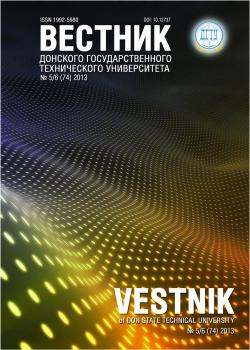The effect of the elbow motion kinematic parameters (angular displacement, velocity, and acceleration) on the surface electromyographic (EMG) signal of the biceps of the arm under the elbow motion execution with different load is analyzed. The dependences of the frequency and amplitude parameters of EMG signals on the elbow mo-tion parameters under load lifting and lowering are established. The test bench structure is shown. The technique of recording EMG signals from the biceps, as well as of the signal processing methods are presented. Methods of statistical and spectral analysis are used for the quantification of the EMG signal values. In the time domain, the statistical analysis includes the determination of the following parameters: EMG amplitude values dispersion, av-erage and RMS values, zero crossing value, waveform length. These parameters are determined on the measured values array basis of the signal generated within 0.3 sec. of the current time (‘sliding’ interval). The developed muscle force value is estimated; the cepstral coefficients are found. EMG biopotential distribution histograms are constructed. In the frequency domain, the EMG signals spectral analysis is carried out by Fast Fourier Transform. The spectrum total power, the average frequency, the median, and a spectral component with the dominant fre-quency are determined. The EMG biopotential registration and analysis are performed by means of Matlab. Infor-mation features which can be used for the intelligent control system synthesis based on neural networks are iden-tified.
passive exoskeleton, elbow motion parameters, electromyographic signal, statistical analysis, spectral signal analysis, Matlab.
Введение. Скелетные мышцы являются совокупностью двигательных единиц (ДЕ). При стимуляции нейронным сигналом каждая ДЕ сокращается и генерирует электромиографический (ЭМГ) сигнал, который представляет собой сумму потенциалов действия всех вовлеченных в процесс клеток [1]. Поверхностная ЭМГ часто используется для оценки относительного уровня мышечной активности во время движений [2]. Известно, что слабые волевые усилия заставляют ДЕ возбуждаться с частотой примерно 5–15 Гц, а при возрастании усилий частота увеличивается до 25–50 Гц с формированием интерференционного типа ЭМГ-сигнала. По мере утомления мышцы наблюдается снижение доли высокочастотных составляющих и увеличение амплитуды ЭМГ [3]. Сигнал ЭМГ, записанный с использованием поверхностных электродов, является сложным, включает в себя интерферирующие составляющие, поэтому его анализ затруднен [4].
1. Rangayan, R. М. Analiz biomeditsinskikh signalov. Prakticheskiy podkhod. [Analysis of biomedical signals. Practical approach.] Moscow : FIZMATLIT, 2007, 440 p. (in Russian).
2. Earp, J.-E., et al. Knee angle-specific EMG normalization: The use of polynomial based EMG-angle relationships. Journal Electromyogr. Kinesiol. Available at: http://dx.doi.org/10.1016/j.jelekin.2012.08.015 (ac-cessed: 04.09.14).
3. De Luca, C.-J. Physiology and mathematics of myoelectric signals. IEEE Transactions on Biomedical Engineering, 1979, vol. 26, pp. 313-325.
4. Konrad, P. The ABC of EMG. A Practical Introduction to Kinesiological Electromyography. Version 1.4, March 2006. Noraxon INC. Available at: http://www.noraxon.com/docs/education/abc-of-emg.pdf (accessed: 04.09.14).
5. Zeeshan, O.-K. Surface EMG pattern recognition for real-time control of a wrist exoskeleton. Biomed-ical Engineering Online. Available at: http://www.biomedical-engineering-online.com/content/9/1/41 (accessed: 04.09.14).
6. Phinyomark, A., et al. Feature Extraction and Reduction of Wavelet Transform Coefficients for EMG Pattern Classification. Electronics and Electrical Engineering, 2012, no. 6, pp. 27-32.
7. Safin, D. R. Informatsionno-izmeritel´naya sistema upravleniya bioelektricheskim protezom : avtoref. dis. … kand. tekhn. Nauk. [Information-measuring management system of bioelectric prosthesis: Cand.tech.sci.diss., author’s abstract.] Astrakhan, 2011, 22 p. (in Russian).
8. Tkach, D., He Huang, Kuiken, T.-A. Study of stability of time-domain features for electromyographic pattern recognition. Journal of NeuroEngineering and Rehabilitation. Available at: http://www.jneuroengrehab.com/content/7/1/21/ (accessed: 04.09.14).
9. Shayduk, А. М., Ostanin, S. A. Analiz spektra kvaziperiodicheskikh impul´sov elektromiogrammy. [Analysis of the spectrum of quasi-periodical pulses of electromiogram.] Journal of Radio Electronics, 2011, no. 8, pp. 1-12 (in Russian).
10. Chernyshev, Y. О., Ventsov, N. N., Mukhtarov, S. A. Razrabotka algoritma intellektual´noy pod-derzhki uluchsheniya promezhutochnykh resheniy optimizatsionnykh zadach. [Algorithm design of intellectual support for perfecting optimization problem intermediate solutions.] Vestnik of DSTU, 2012, no. 5, pp. 68-76 (in Russian).





